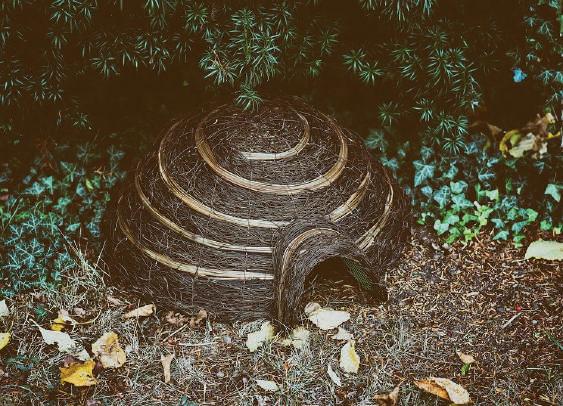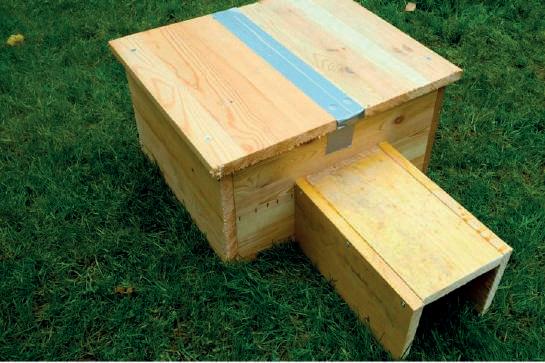
9 minute read
Wildlife
Our Discreet Garden Friend
WHEN I WAS YOUNG, EVERYONE KNEW THE LITTLE HEDGEHOG ERINACEUS EUROPAEUS ( ) AS A WELCOME GARDEN VISITOR, EAGER TO EAT GARDEN PESTS AND DOING NO HARM. THESE DAYS THEY ARE SADLY IN DECLINE
Advertisement

Hedgehogs are a curious race, quite spines and preventing anything getting at unrelated to porcupines. The latter its vulnerable belly. In this defensive are rodents pure and simple, which have posture, a badger is about the only animal adapted their body-hairs into defensive apart from man that can make a meal of spines in the same way as the hedgehog. a hedgehog. There is also another creature called a Tenrec, which lives in Madagascar and other islands in that area, and looks superficially like a small hedgehog. It seems, however, to be completely unrelated to our hedgehog – another example of nature re-inventing a good idea. Hedgehogs can climb a bit, but they are very good at falling. They fall onto their spines, which are bent at the lower end and help cushion the blow. A hedgehog can fall several feet without harm. In this connection, it is worth saying that, if you have a pond or any pit with steep sides, please arrange for one side to slope, or for Hedgehogs are very much Old World some form of ramp to be present, animals. One extinct example has been otherwise the hedgehog can be trapped, found in the rocks of America, and they and drown or starve. were quite unknown in Australia, New Zealand and related territories until they were introduced. Sadly, a hedgehog these days is often a rare sight. Sometimes this is to do with the neighbours. If badgers move into the area, In France we are only liable to find the hedgehogs move out, for reasons European hedgehog. This was originally outlined above. classed among the Insectivores, which meant that the incisor teeth were not especially developed, and the teeth carried sharp projections which intermeshed to promote the efficient crushing of hard insect exoskeletons. It can also have to do with human neighbours. The old adage is, “Good fences make good neighbours”, but hedgehogs are wide-ranging animals, and need to cover large areas of land to find their food. Tight-woven fences, walls etc. prevent Recently those that them from doing so. Please study these matters Most vets will not charge to make sure that there are have realised that the treat an obviously wild gaps enough at groundInsectivora had developed into a bucket-classification animal, especially if they know you are prepared to level in your boundaries to allow, not just access, but movement across your land into which a large give it after-care and into other fields number of creatures and gardens. had fallen, many of which had little or no evolutionary connection with each other. Classifiers do not like that, so the Insectivora has disappeared as a group, and much thought is being expended on re-classifying a whole range of animals, including the hedgehog. And please do not over-preen your garden. Leave some rough areas, a log-pile or two, anything for refuge and a bit of cover. And always remember; hedgehogs love slugs, and eat all they can find. If you are putting down slug-pellets, you are making your slugs poisonous to hedgehogs, and this may be one factor in their reduction. In fact, hedgehogs eat a wide variety of items, mostly the sort of things that a good gardener will approve of. They are noisy little creatures, though, given to loud snuffling (hence the hog part of the name), and when male and female meet to pay Hedgehogs are normally nocturnal creatures, but it is not unusual to see them during the day, especially in autumn. However, a hedgehog out in daylight may be ill – or it may just be hungry. court in the moonlight, the squealing they At this time of the year, hedgehogs are make in mutual serenade is indescribable! preparing for their winter hibernation. The hedgehog is celebrated for its ability to roll up to avoid danger. In fact, in these days of fast cars, rolling-up can lead to more trouble than otherwise, but before that, it was a very good strategy. It used to be said that the fox knows many tricks, but the hedgehog knows one very good trick. What happens is that the little creature Curled up under a pile of leaves or branches, the hedgehog slows his metabolism until it is barely ticking over, and thus it can survive quite punishing conditions. If you decide to burn some accumulated rubbish during the winter, please don’t just set fire to it. Check to see if something is using it for a winter retreat. tucks its snout and paws into its belly-fur In spring the hedgehog will awake, and and then contracts a purse-string muscle push itself into activity by absorbing a that goes all round its lower back and sides special store of fat in its body. In order to and over its neck, thereby pulling its make this fat, of course, and to provide the prickly skin tightly over itself, erecting its stored energy for the winter sleep, the
By Mike George
Mike George is our regular contributor on wildlife and the countryside in France. He is a geologist and naturalist, living in the Jurassic area of the Charente
hedgehog needs to have eaten well in autumn. It must weigh at least 600 grams, and preferably more, by the time it hibernates. This is usually no problem for an adult, but if the late summer has been warm and sunny, some hedgehogs have a late brood of babies, and these usually do not have the time to build up enough fat and will probably die. If you find a small hedgehog wandering forlornly in late autumn or winter, please check its weight. If it is less than ½ kg it is doomed. However, you can save it. Of course, if it is injured, the vet is the first port of call. Bleeding or any obvious injury needs attention, but a check-over anyway is no bad thing. Most vets will not charge to treat an obviously wild animal, especially if they know you are prepared to give it after-care. However, if nothing seems to be wrong, try giving it something to eat. NOT bread and milk; its stomach can’t handle it. Baby hedgehogs can cope with their mother’s milk, but after weaning they lose the vital enzymes to process lactose, and milk gives them diarrhoea. Fish is not good either, mainly because hedgehogs just do not like it! The best thing for your new friend is wet dog or cat food containing white meat. Put the food and some water down and leave the little creature to itself. You can also give them cat biscuits, just be careful of added preservatives in the ingredients. Give it something to hibernate in. A large, stout box, tipped on its side, filled with straw is good. Or try your hand at making the home featured on the next page. Put it near the hedgehog in a cool but frost-free spot such as a shed, greenhouse or barn. The chances are, when the hedgehog has eaten as much as it can, it will crawl into the box and arrange the straw into a nest. Put food and water down for it, and occasionally it will wake and eat some. Be prepared for it to incorporate the dishes into its nest, however, so old crockery only. One word of warning; a sleeping hedgehog snores powerfully, so put the nesting-box out of earshot. In spring, the hedgehog will awaken and potter off about its business without a word of thanks. You, of course, will get a feeling of a job well done and a hedgehog who will keep your garden free of pests!

Win a hedgehog igloo! COMPETITION ON PAGE 7
You can purchase a Gîte à hérisson Igloo for 32€ plus postage from the LPO’s boutique: https://boutique.lpo.fr/catalogue/jardin -d-oiseaux/petite-faune-du-jardin/herisson/gite-a-herisson-igloo

Help the hedgehogs thrive in your garden


It needs a lid for easy access for cleaning inside once the inhabitants have left

A basic home using inexpensive materials (see below)


GIVE A HOG A HOME
The hedgehog pays a heavy price every year for the expansion of our activities - pesticides and slug pellets, intensive agriculture and road traffic, they all have a massive impact on their existence. In France there are only around 20 centres authorised to receive hedgehogs, there are around 800 in the UK. As for the number of hedgehogs saved: 1800 in France per year, against 30,000 in the UK (figures from 2015). With the species in decline, it’s vital we help them thrive in our gardens. Creating a home for them is the perfect way to keep them safe, hibernate during winter and, fingers crossed, have hoglets the following spring. Where you choose to place your hedgehog house will have a big impact on whether it becomes occupied. Ideally, it needs to be nice and quiet and out of direct sunlight, as well as sheltered from the wind. Hedgehogs like to move alongside linear features, such as hedges and fences, so place your house in a corner of your garden if you can. An ideal spot would be under thick vegetation or behind a shed. Cover it with things like leaves and woody garden cuttings for extra shelter and security. Your hedgehog home can be as basic or sophisticated as you wish. Here are the instructions for a fairly simple one:
You will need:
− One length of 15cm x 2cm untreated timber, which is 1.2m long. (Make sure the wood is from a sustainable source) 25mm galvanised nails 1m length of hosepipe
A jigsaw, drill and hammer 25mm drill bit
How to make a simple hedgehog home:
1.
2.
3.
4.
5. Make the tunnel that will form the entrance of your hedgehog house. To do this, cut your sustainable timber into four separate lengths that are all 30cm long. Nail these together, lengthways, to form a tunnel. Now take the wine crate. Using the jigsaw, cut an entrance hole into one side of the crate, at the base. The hole should measure 11cm x 15cm. Attach your tunnel to this entrance hole, nailing it from the inside of the crate. Drill a hole that will fit the hosepipe into the back of the crate. Make the hole near the top, with the hose resting on the ground outside - that way air can get in but not rain. The hosepipe will ventilate your hedgehog house and keep hogs feeling cosy. Finally, place the top back on the crate, but don’t nail it shut! You’ll need to take it off and tidy up the house every year or two. This is best done during October before hogs go into hibernation.










